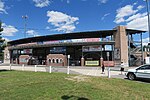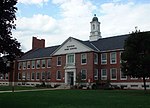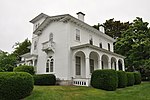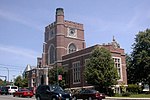The Boston Consolidated TRACON (A90) is located in Merrimack, New Hampshire. A90 opened in 2004 after 8 years of development. The A90 function transferred to the new Boston Consolidated TRACON on February 22, 2004. The MHT function transferred over on March 7, 2004. Manchester TRACON used to be located at Manchester Airport below the old ATCT. Boston TRACON used to be located at the Logan International Airport Control Tower before being consolidated. The new facility is 63,000 square feet (5,900 m2). A Terminal Radar Approach Control, or TRACON, is responsible for descending airplanes from the ARTCC and lining them up for landing at their destination airport, as well as climbing departures before handing off to the ARTCC.
The primary responsibility of the Boston TRACON is the safe, orderly, and expeditious flow of arrival, departure, and en-route traffic. A90 is responsible for one main airport, Boston Logan International Airport. Additionally, A90 is responsible for dozens of smaller but busy fields, including Manchester-Boston Regional Airport, Hanscom Field, Norwood Memorial Airport, Beverly Municipal Airport, Lawrence Municipal Airport, Portsmouth International Airport at Pease, and Nashua Airport.
The Boston TRACON is one of six "Medium TRACONs" currently existing throughout the United States. The others include the Salt Lake TRACON, the Bradley TRACON, the Indianapolis TRACON, the Pensacola TRACON, and the Des Moines TRACON.
According to the FAA Air Traffic Activity Data System below are the traffic counts for A90:
2005 729,625 ops
2006 710,765 ops
2007 693,158 ops
2008 639,782 ops
2009 603,131 ops
2010 634,151 ops
2011 626,137 ops
2012 595,823 ops
2013 603,974 ops
2014 604,516 ops
2015 615,078 ops
2016 639,759 ops
2017 658,524 ops
2018 805,780 ops
2019 824,230 opsA90 is part of the FAA New England District. The Boston Consolidated TRACON is considered the HUB facility for the following facilities:
Bangor ATCT/TRACON
Manchester ATCT
Boston ATCT
Providence ATCT/TRACON
Cape TRACON - Which was consolidated to A90 in February 2018 as part of the FAA's efforts to reduce its infrastructure footprint.
Bedford ATCT
Nantucket ATCT
Portland ATCT/TRACON
Burlington ATCT/TRACON











